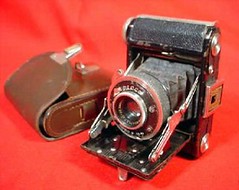Baby Lyra
The Baby Lyra (ベビーライラ) is a Japanese 3×4 folder made by Fuji Kōgaku from 1936. Its main competitor was the Baby Pearl by Konishiroku.
Contents
Description
The Baby Lyra is a vertical folding camera copied on the Baby Ikonta. It has a folding frame finder. The advance knob is at the bottom right, as seen by a photographer holding the camera horizontally. The back is hinged to the left and contains two uncovered red windows to control the film advance. The name LYRA is embossed in the front leather. The FUJI KOGAKU logo is engraved in the folding struts and embossed in the back leather.
The shutter is an everset Picco giving T, B, 25, 50, 100 speeds. The aperture scale is at the bottom of the shutter plate and the Picco name is at the top, with an FK logo on the right. There is no body release and the lens is front-cell focusing.
  
|
| Baby Lyra, Terionar f/4.5 lens, Picco shutter. The front leather is perhaps not original. Pictures courtesy of Ed Barton. (Image rights) |
Evolution
The Baby Lyra was advertised in Japanese magazines from June 1936.[1] Advertisements dated December 1936, September 1937 and September 1938 list three versions of the camera:[2]
- Pionar f/6.3 lens (¥25 in 1936 and 1937, ¥28 in 1938);[3]
- Terionar f/4.5 lens (¥32 in 1936 and 1937, ¥36 in 1938);[4]
- Terionar f/3.5 lens (¥42 in 1936 and 1937, ¥46 in 1938).[5]
The focal length is certainly 50mm in all cases.[6]
The last reported advertisement is dated October 1938.[7] However the Baby Lyra is still mentioned in the official list of set prices compiled in October 1940 and published in January 1941, in three versions called "Baby Lyra L" (¥28), "Baby Lyra Y" (¥44) and "Baby Lyra R" (¥50).[8] They certainly correspond to the three lens and shutter combinations described above. Their names form the word "L-Y-R" in ascending price order and this is certainly not casual.
The Baby Balnet was perhaps the successor of the Baby Lyra. The Baby Leotax and the folding Baby Germa have a similar body, and were perhaps copied on the Baby Lyra.
Notes
- ↑ Advertisements listed in Kokusan kamera no rekishi, p.342.
- ↑ Advertisement (archived) by the distributor Yamamoto Shashinki-ten in Sunday Mainichi, December 13, 1936, reproduced at Gochamaze (archived); advertisement in Asahi Camera September 1937, reproduced in Kokusan kamera no rekishi in two parts, p.100; advertisement in Asahi Camera September 1938, observed in an online auction.
- ↑ This version is pictured here at Asacame and has been observed in an online auction.
- ↑ This version is pictured in this page, in Zaisu, p.6 of Camera Collectors' News no.57, and here at Tomei Collection.
- ↑ This version is pictured in Sugiyama, item 1166, and in Omoide no supuringu-kamera-ten, p.15.
- ↑ The lens names are only mentioned in the September 1937 advertisement, not in the ones dated December 1936 and September 1938, but we can probably assume that they were unchanged.
- ↑ Advertisements listed in Kokusan kamera no rekishi, p.342.
- ↑ "Kokusan shashinki no kōtei kakaku", type 1, sections 3, 4A and 6A.
Bibliography
- Asahi Camera (アサヒカメラ) editorial staff. Shōwa 10–40nen kōkoku ni miru kokusan kamera no rekishi (昭和10–40年広告にみる国産カメラの歴史, Japanese camera history as seen in advertisements, 1935–1965). Tokyo: Asahi Shinbunsha, 1994. ISBN 4-02-330312-7. Item 291. (See also the advertisement for item 164.)
- "Kokusan shashinki no kōtei kakaku" (国産写真機の公定価格, Set prices of the Japanese cameras), listing Japanese camera production as of October 25, 1940 and setting the retail prices from December 10, 1940. Published in Asahi Camera January 1941 and reproduced in Shōwa 10—40nen kōkoku ni miru kokusan kamera no rekishi (昭和10〜40年広告にみる国産カメラの歴史, Japanese camera history as seen in advertisements, 1935—1965). Tokyo: Asahi Shinbunsha, 1994. ISBN 4-02-330312-7. Pp.108—9. Type 1, sections 3, 4A and 6A.
- McKeown, James M. and Joan C. McKeown's Price Guide to Antique and Classic Cameras, 12th Edition, 2005-2006. USA, Centennial Photo Service, 2004. ISBN 0-931838-40-1 (hardcover). ISBN 0-931838-41-X (softcover). P.328.
- Omoide no supuringu-kamera-ten (思い出のスプリングカメラ展, Exhibition of beloved self-erecting cameras). Tokyo: JCII Camera Museum, 1992. (Exhibition catalogue, no ISBN number.) P.15.
- Sugiyama, Kōichi (杉山浩一); Naoi, Hiroaki (直井浩明); Bullock, John R. The Collector's Guide to Japanese Cameras. 国産カメラ図鑑 (Kokusan kamera zukan). Tokyo: Asahi Sonorama, 1985. ISBN 4-257-03187-5. Item 1166.
- Zaisu Ikon (座椅子遺恨, probably a pseudonym of Y. Saji). "Besuto sanka (B-1)" (ベスト讃歌[B-1], Vest hymn [B-1]). In Camera Collectors' News no.57 (March 1982). Nishinomiya: Camera Collectors News-sha. P.6.
Links
In Japanese:
- Page with a Baby Lyra in the A-Z 127 film cameras at Asacame
| Fuji Kōgaku cameras () | ||||
|---|---|---|---|---|
| prewar and wartime models | postwar models | |||
| 3×4 | 4×6.5 | subminiature | 4×4 | subminiature |
| Baby Lyra | Baby Lyra Flex | Baby Balnet | Dianette | Pionette | Lyravit | Balnet Four | Comex |
| 4.5×6 | 6×6 | 6×9 | 4.5×6 | 6×6 |
| Bakyna | Semi Lyra | Lyrax | Lyra Six | Lyra Flex | Lyra (6×9) | Semi Lyra | Pioneer | Lyra Six | Lyraflex |
